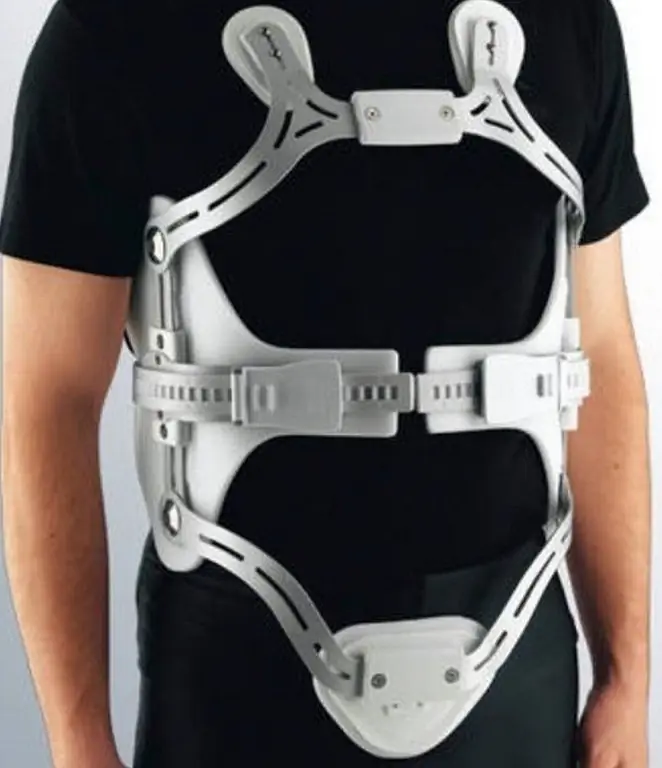- Author Rachel Wainwright [email protected].
- Public 2023-12-15 07:39.
- Last modified 2025-11-02 20:14.
Hernia of the cervical spine
The content of the article:
- Causes and risk factors
- Forms of the disease
- Symptoms of a hernia of the cervical spine
- Diagnostics
- Treatment of a hernia of the cervical spine
- Possible complications and consequences
- Forecast
- Prevention
A hernia of the cervical spine (intervertebral hernia of the cervical spine, herniated disc of the cervical spine) is a disease in which there is a rupture of the fibrous ring of the intervertebral disc in the cervical spine, as a result of which the intervertebral disc loses its cushioning functions.
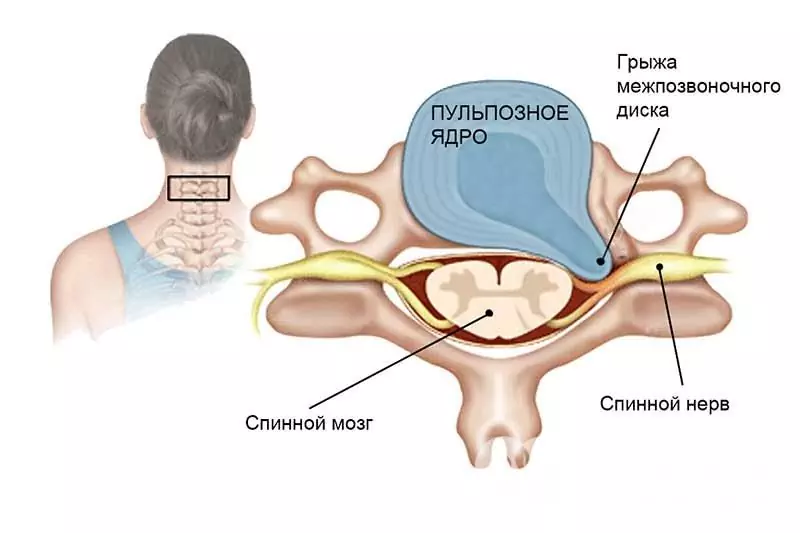
The clinical picture of a hernia of the cervical spine
In terms of prevalence, the disease ranks second after a hernia of the lumbar spine in the general structure of vertebral hernias. Most often, a hernia forms in the discs between the fifth and sixth, as well as between the sixth and seventh cervical vertebrae. Less often, the pathological process occurs between the fourth and fifth cervical vertebrae, extremely rarely - between the seventh cervical vertebra and the first thoracic vertebra. The average age of patients with a hernia of the cervical spine is 30-50 years.
The cervical spine is responsible for the movement of the neck that allows the head to turn and tilt. This section is the most mobile and consists of seven vertebrae. The first and second cervical vertebrae connect the spine to the skull and differ in structure. The first cervical vertebra does not have a body, but there are anterior and posterior arches. The body of the second cervical vertebra has a dentate process, which articulates with the inner surface of the anterior arch of the first cervical vertebra and reaches the level of the foramen magnum. Intervertebral discs, which are located between the bodies of two adjacent vertebrae, consist of an annulus fibrosus and nucleus pulposus. With the development of a hernia, the fibrous ring breaks, the disc protrudes, leading to compression of the nerve roots and the occurrence of pain. A feature of this anatomical area is thatthat on both sides of the bodies of the cervical vertebrae are vertebral arteries. For this reason, a hernia of the cervical spine manifests itself not only with neurological disorders, but also with vascular disorders. The vertebrae in this section are smaller in comparison with the thoracic and lumbar, therefore, hernias of the cervical spine are smaller than intervertebral hernias of other sections. Nevertheless, due to the anatomical and morphological features of this area, even small protrusions of the intervertebral discs can lead to the onset of the disease.therefore, hernias of the cervical spine are smaller than intervertebral hernias of other parts. Nevertheless, due to the anatomical and morphological features of this area, even small protrusions of the intervertebral discs can lead to the onset of the disease.therefore, hernias of the cervical spine are smaller than intervertebral hernias of other parts. Nevertheless, due to the anatomical and morphological features of this area, even small protrusions of the intervertebral discs can lead to the onset of the disease.
Causes and risk factors
The development of a hernia of the cervical spine is due to the degenerative processes occurring in the intervertebral disc, as a result of which it loses its elasticity. Acute trauma of the spine (subluxation of the cervical vertebrae, contusion of the spine) or regular trauma with increased stress on this area can contribute to the onset of the disease. Also, a hernia of the cervical spine can occur against the background of diseases such as osteochondrosis, tuberculosis of the spine, spondyloarthrosis, cervical spondylosis, as well as anomalies in the development of the spine (wedge-shaped vertebrae, short neck syndrome, atlas assimilation).
Risk factors include:
- genetic predisposition;
- metabolic disorders;
- overweight;
- improper posture;
- sedentary lifestyle;
- constant dehydration of the body;
- alcohol abuse;
- tobacco smoking.
At risk are representatives of such professions as dancers, athletes, drivers, as well as people whose work activities are associated with vibration or working in a hot workshop.

Athletes are at risk of developing a hernia of the cervical spine
Forms of the disease
Hernias of the cervical spine can be primary and secondary (in this case, the hernia is a consequence of another disease).
Depending on the localization, the following hernias of the cervical spine are distinguished:
- hernia C4-C5 (between the fourth and fifth cervical vertebrae);
- hernia C5-C6 (between the fifth and sixth cervical vertebrae);
- hernia C6-C7 (between the sixth and seventh cervical vertebrae);
- hernia C7-T1 (between the seventh cervical and first thoracic vertebrae).
Symptoms of a hernia of the cervical spine
The first signs of a hernia of the cervical spine, as a rule, appear spontaneously. In the initial stages, the symptoms of a hernia of the cervical spine are pain, the localization of which depends on which part of the cervical spine is involved in the pathological process. With a C4-C5 hernia, the pain is localized in the region of the deltoid muscle and the forearm; numbness of the hand is usually not observed. Painful sensations can occur when raising the upper limb above the horizontal line. With a C5-C6 hernia, the pain is localized in the area of the outer part of the elbow, biceps. Thumb may go numb. With a C6-C7 hernia, pain is noted in the triceps region, as well as the thumb, the outer part of the forearm, the middle finger of the hand may go numb. Hernia C7-T1 is manifested by muscle weakness in the hand and its numbness, pain in the little finger.

Hernia of the cervical spine C4-C5 is manifested by pain in the forearm and deltoid muscle
At first, the pain occurs periodically, provoked by tilting and turning the head. With the progression of the pathological process, the pain sensations become constant, aggravated with any head movements. Often the pain is accompanied by paresthesias and numbness of the upper limb. An increase in the tone of the muscles of the neck leads to limited mobility and increases pain.
Due to the compression of the hernia of the nerve fibers of the spinal root, radicular syndrome occurs (the appearance of pain in different parts of the body), and partial or complete loss of pain or other types of sensitivity in the area innervated by the compressed nerve roots can also develop. As the pathological process progresses, weakness appears in the upper limb, accompanied by a decrease in muscle tone. When the vertebral artery is compressed, headaches, attacks of dizziness, sleep disturbances, impaired coordination of movements and gait, fainting, tinnitus, visual disturbances, sudden changes in blood pressure, sore throat and mild cough appear. With an increase in the size of the hernia and compression of the spinal cord, the patient may develop discogenic myelopathy.
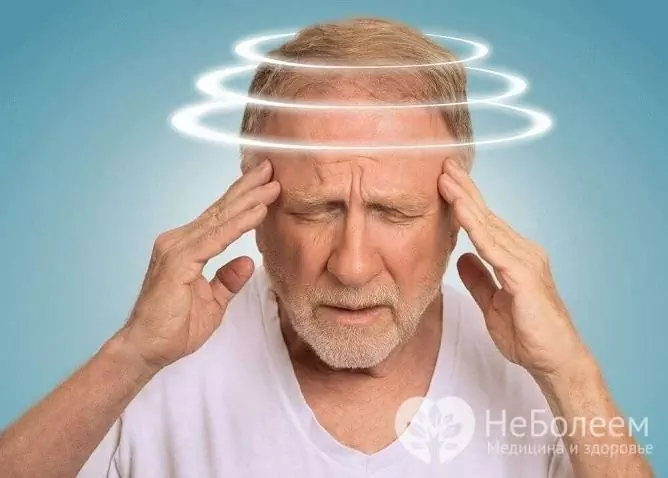
If the hernia compresses the vertebral artery, the patient experiences headaches and dizziness
Diagnostics
In order to diagnose a hernia of the spine, anamnesis is collected, an objective examination of the patient, and a study of reflexes. To confirm the diagnosis, instrumental examination methods are used:
- X-ray examination of the spine - allows you to identify pathological changes in the spinal column;
- computed tomography - performed according to the same indications as radiography, allows you to get a more detailed image;
- magnetic resonance imaging - makes it possible to visualize the soft tissue structures of the spine, to determine the degree of narrowing of the spinal canal and the size of the hernia) of the spine.
Electromyography, electroneurography or electroneuromyography are used to determine lesions of a neural nature. The state of the vertebral artery can be assessed by Doppler ultrasound, duplex scanning, rheoencephalography with functional tests.
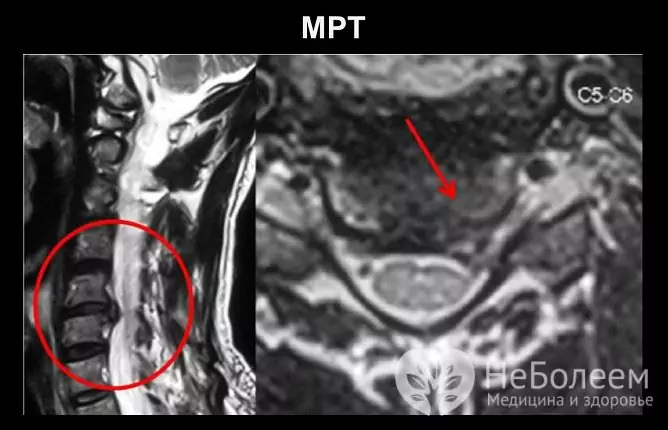
Hernia of the cervical spine C5-C6 on MRI
Differential diagnosis is carried out with infectious myelopathy, cervical myositis, cervical plexitis, brachial plexitis, humeroscapular periarthrosis.
Treatment of a hernia of the cervical spine
Conservative therapy for a hernia of the cervical spine includes taking anti-inflammatory drugs, analgesics, muscle relaxants, neurometabolic drugs.
Of the physiotherapeutic methods, electrophoresis, phonophoresis, magnetotherapy, ultra-high-frequency therapy are effective. The use of manual and traction therapy helps to reduce the pressure on the pathologically altered intervertebral disc. Reflexology and myofascial massage can reduce the intensity of painful muscle spasms. The main treatment can be supplemented with herbal medicine and hirudotherapy (treatment with medicinal leeches).
At the initial stage of the disease, the cervical spine can be relieved by wearing a Shants collar (splint), which is an alternative to bed rest. To strengthen the muscle corset, exercise therapy is further prescribed. Exercises for a hernia of the cervical spine are selected by the attending physician individually. The course of physiotherapy exercises usually begins with breathing exercises, gradually added exercises aimed at strengthening the muscles of the upper limbs, and then the muscular corset of the neck. The rehabilitation course for patients with a hernia of the cervical spine is 1-3 months. During treatment and rehabilitation, it is recommended to avoid sudden temperature changes.
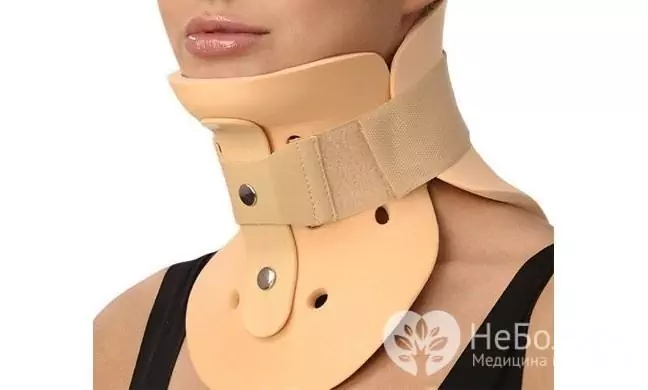
With a hernia of the cervical spine of the initial stages, a Shants collar is used to unload the muscles
Indications for surgical treatment of a hernia of the cervical spine may be a significant neurological deficit, which does not decrease with drug therapy, compression of the vertebral artery, pronounced narrowing of the spinal canal, the ineffectiveness of conservative therapy with severe (especially increasing) symptoms.
For small hernias, they resort to minimally invasive interventions:
- intradiscal electrothermal annuloplasty (intradiscal electrothermal therapy);
- endoscopic microdiscectomy;
- puncture percutaneous laser vaporization.
From the methods of surgical treatment for hernia of the cervical spine, partial or complete removal of the intervertebral disc (classical discectomy, microdiscectomy), as well as operations that allow additional fixation of the spine (intervertebral stabilization with cages, interbody fusion) can be used. In most cases, complete removal of the intervertebral disc is performed, since with partial removal of the disc, there is a high risk of recurrence of a hernia of the cervical spine.
Possible complications and consequences
A hernia of the cervical spine can be complicated by the development of a stroke, cervical radiculitis, as well as an infringement of the spinal cord, which, in turn, can lead to paralysis.
Forecast
With timely diagnosis and a correctly selected therapy regimen, the prognosis is favorable. In the absence of treatment or the patient's failure to comply with the doctor's prescriptions, an increase in symptoms leads to a significant decrease in the quality of life, up to disability, and the risk of complications increases,
Prevention
In order to prevent a hernia of the cervical spine, it is recommended:
- timely treat diseases and injuries that can lead to the development of pathology;
- avoid uncomfortable head positions, sharp neck movements;
- eat rationally;
- to refuse from bad habits;
- sleep on an orthopedic mattress;
- lead an active lifestyle, have sufficient, but not excessive physical activity;
- control body weight.
YouTube video related to the article:

Anna Aksenova Medical journalist About the author
Education: 2004-2007 "First Kiev Medical College" specialty "Laboratory Diagnostics".
The information is generalized and provided for informational purposes only. At the first sign of illness, see your doctor. Self-medication is hazardous to health!




